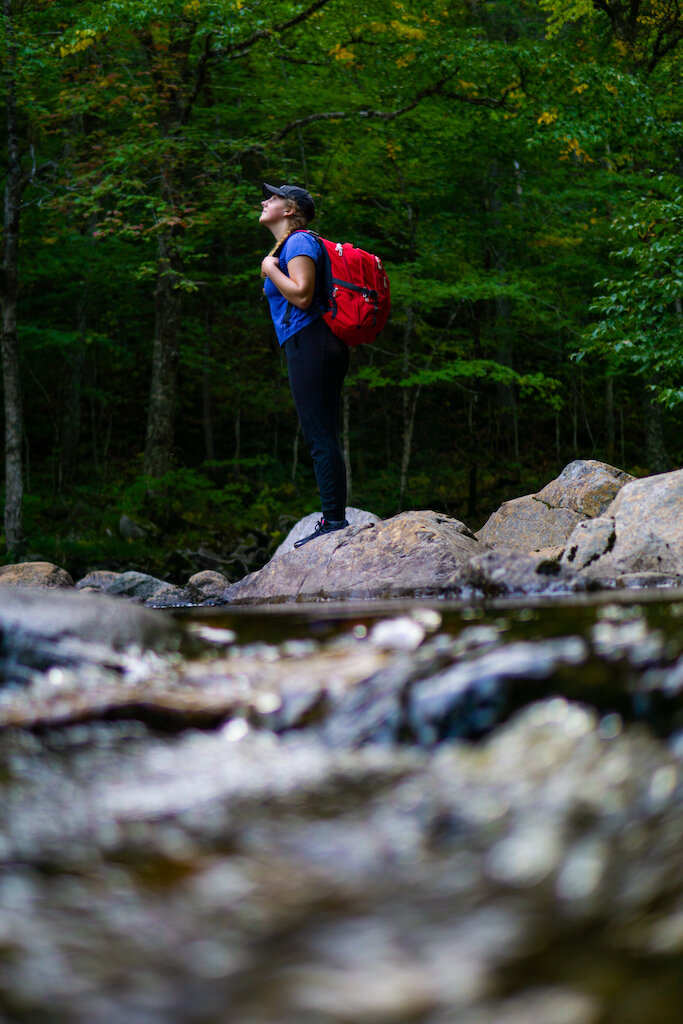5 tips on hiking sustainably
I’ve seen it too many times to count. I’m out on a hike, surrounded by so much natural beauty that it takes my breath away. I look up at towering trees, listen to the bubble and babble of the river beside me, breathe deep to take in the ocean air and then… what’s that on the ground? But I already know. We all do, don’t we? Garbage. A granola bar wrapper. A plastic water bottle, dirtied and shoved under a branch. And that’s not all. I’ve seen it on much larger scales, too. Ripped towels and old t-shirts, shoved under a rock. Pots and pans, sleeping bags left behind. Garbage bags caught in bushes 7 kilometres into the woods. One time, my friends and I were camping, enjoying this stunning view of the ocean on a backcountry hike in our national park when something caught our eye. There are designated platforms for people to pitch their tents on and underneath we could see piles and piles of stuff. Oh no, we said, someone must have forgotten their things! But as we bent down to take a closer look we realized the entire platform was rammed full of garbage. Ketchup bottles, paper towel, old clothes, wrappers, cups, bottles. Oh yes, a gorgeous view of the ocean while sitting on top of a bunch of trash. Sign me up.
Cape Breton’s backyard is this massive, beautiful playground. Full of wild, untamed beauty, breathtaking sights and mature forest. More and more people are beginning to flock here to experience all that this island has to offer. And, heartbreakingly, inevitably, more and more trash is piling up. As a company, we want more than anything for people to come and see this amazing place that we call home and we want them to keep coming for a long time. For forever, if we have our way. As proud Cape Bretoners, we want them to see it just as it is: rare, untouched, gorgeous nature.
So how do we get there? And when we get there, how do we stay there? Let’s start with the most obvious…
don’t litter.
Shocking, I know. But for some reason thousands of people are making their way here and leaving their trash behind while expecting to return the next summer for a beautiful experience. We get it, life is stressful and vacationing to the ocean is like taking a deep breath, but it will get harder to breathe with more garbage you leave behind. So… don’t. You can limit the amount of garbage you produce on your day hikes or backpacking by preparing and packing wisely. Bring a garbage bag that you know will seal well and when you’re back home or at your airbnb or hotel, dispose of it the right way. And then, come back next year.
2. Separate your garbage and your recyclables.
I mean, to begin with, it’s the law. If you go through the trouble of bringing bags and taking out what you brought in but then just toss it all in the same garbage can, it defeats the point. Make your hard work worth it and bring a second bag to separate your things. It really doesn’t take up much extra space and adds virtually no weight!
3. If you see trash, pick it up.
Might sound a little gross and I know that you weren’t the one who put it there. I used to just shake my head when I walked by garbage on the trail and say “How sad. I can’t believe people would just leave this here.” And then I would walk right by and, um, leave it there. I never thought much about it because that’s how people around me reacted, too. That, or we would all just pretend we didn’t see it and walk ahead all of a sudden very fascinated on that tree just up the trail. Yes, that’s how we all acted. Until last summer when I met someone who would literally pull over on the side of the road when he was driving if he saw trash just to pick it up (what kind of person even does that?). He never walked by anything, not even the gross things, without taking it with him. He packed extra bags when he went hiking. And unless he honestly didn’t have the room or the ability to carry it, he would take it. So I started to do it, too. I stopped shaking my head and thinking, “oh how sad,” while doing nothing to change the problem. I started to pack extra bags. And you know what? As we picked up stuff on the trails, other people watched us and started to do it too. It had this crazy ripple effect. Strangers around me walked out with armfuls of trash or bags of it stashed in their backpacks. And all those times I didn’t do anything because others around me weren’t, I wonder if they were doing the same thing. Feeding off of my energy, my actions. The things we do matter and they will have a ripple effect. So pack an extra bag, and don’t walk by what someone left behind.
4. Invest in a water filter.
This was a game changer to me! If you are hiking in Cape Breton there is a high chance you’ll be passing rivers, streams and lakes. Instead of having to buy bottles of water from a gas station on your way, having a water filter with a reusable bottle means that you save money and you get to save carrying litres and litres of extra weight on your back. Plus, you will be limiting your plastic use. I usually bring my Grayl water bottle/ filter and my insulated hydroflask to keep my water cold. I’ve been out on an overnight hike in the sweltering heat of summer where I started with nothing but an empty water bottle because I knew I could purify water whenever I needed to. Save the extra weight, save the plastic, buy the filter.
* Please also check ahead using a reliable source like alltrails.com to make sure that your hike, will, in fact, have a water source. Without that, this little piece of advice is useless for some hikes.
5. Pick sustainable outdoor brands.
I know that buying things from sustainable companies can get pricey, but they can often last you decades which, really, saves you from having to continually buy more things as yours get worn out. There are brands that minimize their impact on the environment. Buying from them means that you are, too. Companies like Patagonia, Marmot, Merrell and Vaude are good, reliable places to start.
I understand that you probably can’t invest in a bunch of things at once. Neither can I! Just start where you can with what you like. Buy things that you will use often and remember that it is good for the environment, which means it’s good for you.
P.s. Don’t forget to enjoy it all. We want you to come and experience this amazing island. There are beautiful trails, hard hikes and gorgeous views just waiting for you and our hope in sharing this is that it will always stay this way so that you can come and have the very best experience possible.
Written by: Annika Phillips





